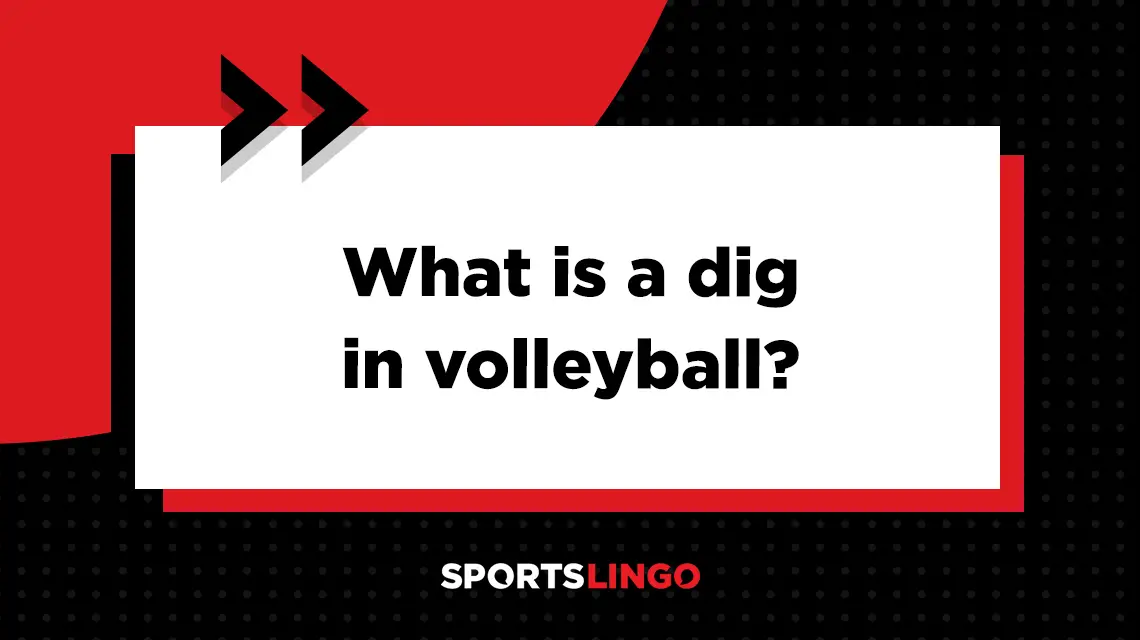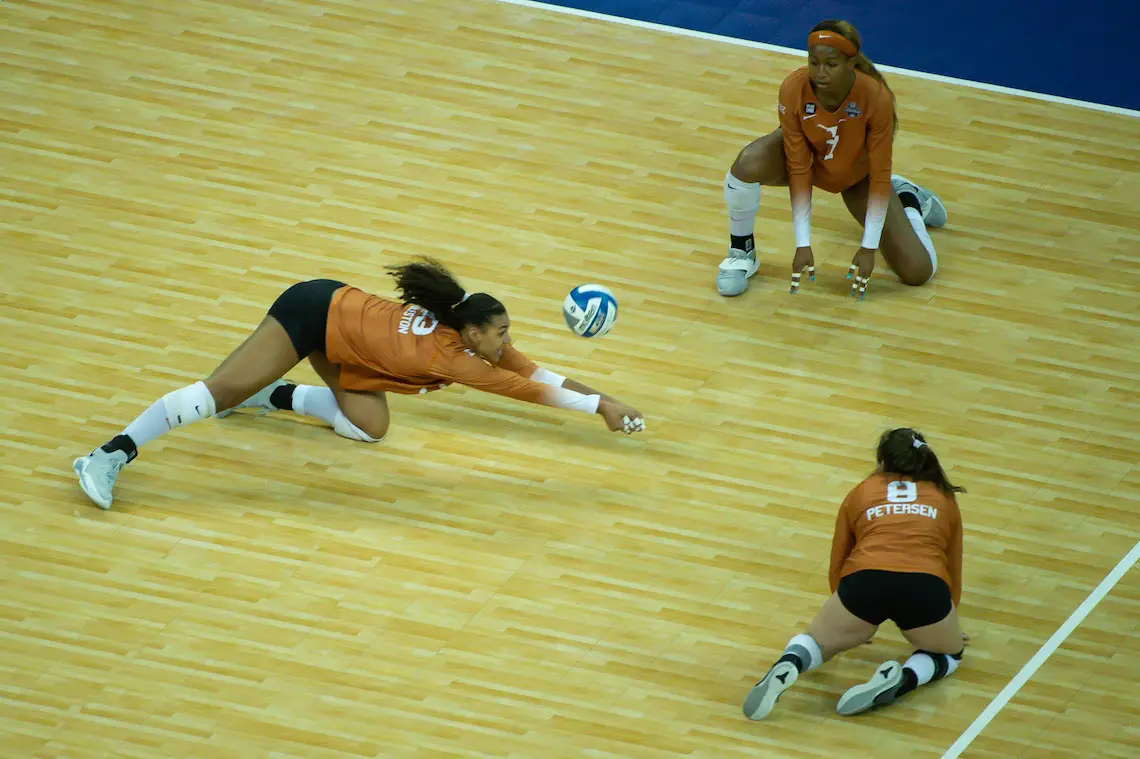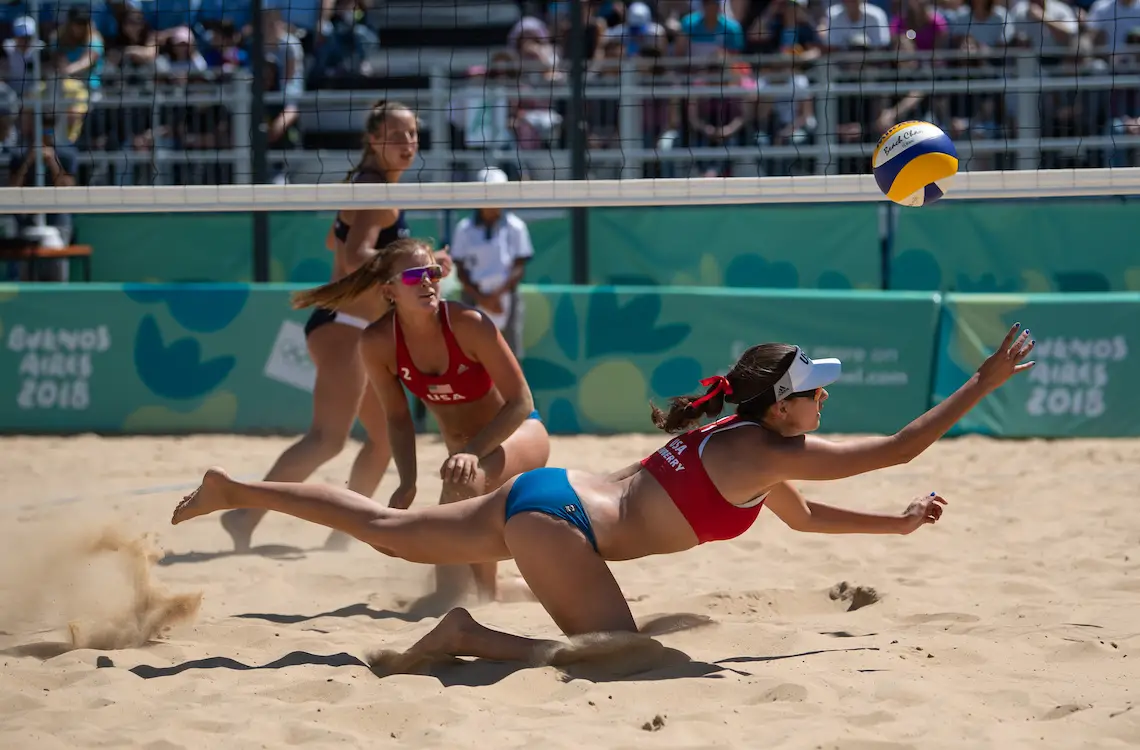
dig
What is the definition of dig in volleyball?
1. A dig refers to when a volleyball player prevents the ball from hitting the ground on their side of the net after an opponent has spiked or served the ball toward them.
What is the difference between a pass and a dig in volleyball?
In volleyball, digging is a form of passing, but not all passes are digs. Digs occur after an opponent serves or spikes the ball.
Volleyball digs may not always be perfect passes to a teammate, as the goal of a dig is to keep the ball playable and continue the rally, whereas passes prioritize setting up a teammate to score.
What is considered a dig?
A volleyball dig only occurs when a player passes a ball that is an attack attempt. For example, if the opponent serves the ball or spikes it over the net, it is an attempted attack on passer’s team. If a player is able to get under the ball and pass it, that pass is considered a dig.
On the other hand, if the ball is touched by a player’s teammate first before the player passes it, that would not be considered a dig. Instead, it would just be a regular pass. Similarly, if an a player on the opposing team is just trying to get the ball over the net but not making a purposeful attack, the player would not be making a dig if they pass that ball.
For example, an opponent might gently pass the ball over the net in order to avoid a four-hit violation. Then, the player could pass in an effort to set the ball up for a setter or hitter to help create a scoring opportunity. This would be a regular pass rather than a dig since it was not an attack attempt.
What is the point of digging in volleyball?
A volleyball dig is a defensive play that prevents the other team from scoring. If a player is not able to dig the ball off of an attack or serve, the other team will score.
What is the benefit of getting a dig in volleyball?
When performed successful, a dig in volleyball can help to set up a scoring opportunity for a player’s team. A dig keeps the ball in play so that the team can continue the rally and try to respond to an attack from their opponents with their own attack.
Why is it important to dig in volleyball?
Hard-driven balls are very difficult to defend. A dig can help to thwart a scoring attempt from an opponent. Defending players in the back row often specialize in this skill in order to help set up their volleyball team’s front row players for scoring opportunities.
How do you get a dig in volleyball?
Off of service, a player stays low and tries to pop the ball up, keeping their arms parallel to the floor to prevent shanking the ball. Ideally, they’ll be able to direct the ball toward one of their teammates to help set up a scoring opportunity.
Off of a spike, a player moves their feet quickly or dives close to the ball’s trajectory and stretches one or both hands out to keep the ball in play. If completed successfully, the ball should remain playable.

Steven Branscombe/USA TODAY Sports
What are some skills that are needed to be a good digger in volleyball?
The following are some key skills that make a volleyball player good at digging:
- Quick reaction time: An attacked ball travels rapidly, and the faster a player can respond, the more likely they are to dig the ball successfully. Explosive movement is often required to dig in volleyball, so players need to be able to react quickly.
- Flexibility: When digging, players need to bend low to the ground and be able to move forward, backward, and laterally as needed. A full range of motion contributes to better digs.
- Reading the game: Players who watch the opposing team closely will be better able to anticipate where the ball is headed based on the way an opponent has positioned their body. It also helps to pay attention to which areas of the court an opponent favors when serving or spiking the ball.
For beginners, digging drills can be an effective way to develop these skills. Digging drills often involve reps in which help players practice the skills they need to dig effectively. Many teams include digging drills in their warm-ups since digs are such an important part of a team’s defense.
Tips for successful digs in volleyball
There are a number of ways to improve your digs in volleyball. These techniques start before the ball comes over the net and continue through the way you take a ready stance and how you touch the ball when it’s time to dig.
Keep your eye on the ball
Before a serve or a hit from your opponent, make sure you’re closely watching the other team. The movements they make can help to indicate where the ball may go once they make an attack. Before a hit, watch where your team’s blockers are as well. This can indicate which areas are protected and which ones you need to cover if the ball makes it past them.
Assume a ready position
The stance that a volleyball player takes before an attack is important for completing successful digs. A ready position requires you to have your feet about twice your shoulder width apart with the knees bent. In addition, you must bend forward at the waist so that your shoulders are above your knees and when you reach down, your fingertips touch the floor.
Keep your weight on your toes so you’re ready to move in any direction at a moment’s notice, and have your arms bent and slightly out to the sides.
Use the right digging technique
Once an attack is made, it’s time to retrieve the ball with a dig. If possible, position the hips and shoulders in the direction that you want the ball to go. Getting your body behind the ball helps to prevent shanking it in a way that’s difficult for your teammates to retrieve.
If you’re able to, use both arms to dig the ball. Join the forearms together and extend them in front of you to create a platform for a bump pass. This is the ideal way to dig since you’ll have more control over the direction of the ball and have a better chance at sending it to your target area.
If a hard-driven ball is moving too quickly or far from your body to get both arms under it, extend one forearm instead. This is much trickier to achieve successfully since there’s a greater chance that the ball will shank toward the back or side of the court. However, with practice, skilled diggers are often able to get a decent pass off of a one-armed dig.
A less common way of digging an attacked ball is an overhand dig. This technique is sometimes used by players in the front row, such as blockers and outside hitters, who aren’t able to use their forearms to dig because the ball is traveling toward them at shoulder height or higher. Depending on the velocity of the ball, a player can set it toward a team member or simply bring their arms up to bounce the ball off their forearms or the heel of their hand in order to avoid a hard hit to the face or body.
What is a pancake in volleyball?
A pancake is a type of defensive play that can be used for balls that are hard to dig. It’s often used in last-ditch efforts to keep the ball in play and prevent the opposing team from scoring a point.
To do a pancake, dive toward where the ball is about to land and extend your arm in front of you. Keep your palm facing down and flatten your hand on the floor of the court where the ball is landing. Allow the ball to hit the back of your hand so that it pops up and another one of your teammates can hopefully get to it for a pass.

Jonathan Nackstrand/USA TODAY Sports
Who is the best digger on the team?
Typically, the libero is the volleyball position which is the best at digging. Because liberos are usually the shortest players on the team, they have the lowest center of gravity which allows them to retrieve difficult digs without losing their balance.
Other defensive players in the back row may also be skilled diggers. Regardless of their position and talents, all players on a volleyball team need to practice digging since it is such an essential skill for the game.
How are passes rated in volleyball?
Passes in volleyball, including digs, can be rated individually. A player’s passing grades can be averaged to give them an overall pass rating. The value of a pass is determined by the following scale that ranges from zero to three:
- 0 Pass = No pass is made, resulting in a point for the opposing team.
- 1 Pass = A poor pass or shank that is difficult for teammates to reach.
- 2 Pass = A mediocre pass that limits the options to get the ball over the net.
- 3 Pass = A perfect pass that allows the team to easily set up an attack.
A player should aim for a pass rated as three when digging.
SportsLingo goes the extra-inch with the meaning of dig
Although it is preferred to dig the ball with both hands, many times a player doesn’t have the time to bring both hands together to receive the ball. A player may dive and try to dig the ball simply with one arm and a balled fist.
One method of digging the ball when a player has little time to react or the ball is nearly out of reach is by using a move called the flipper, when the player dives with an arm outstretched and their palm facing down and makes contact with the top of their hand. This is similar to the pancake technique described above.
Examples of how dig is used in volleyball
1. With the game on the line, Jenia Grebennikov makes a diving dig to keep the play alive.
Sport the term is used
1. Volleyball